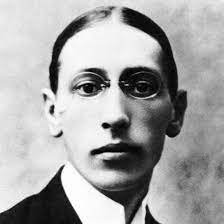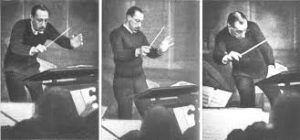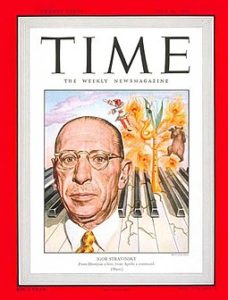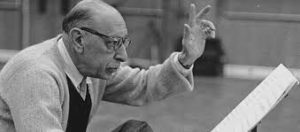 Igor Fyodorovich Stravinsky (June 1882 – 6 April 1971) a Russian-born composer, pianist and conductor widely considered one of the most important and influential composers of the 20th century, whose work had a revolutionary impact on musical thought and sensibility just before and after World War I. He was honoured with the Royal Philharmonic Society Gold Medal in 1954 and the Wihuri Sibelius Prize in 1963.
Igor Fyodorovich Stravinsky (June 1882 – 6 April 1971) a Russian-born composer, pianist and conductor widely considered one of the most important and influential composers of the 20th century, whose work had a revolutionary impact on musical thought and sensibility just before and after World War I. He was honoured with the Royal Philharmonic Society Gold Medal in 1954 and the Wihuri Sibelius Prize in 1963.
As a boy he was given lessons in piano and music theory but then he studied law and philosophy at St. Petersburg University (graduating in 1905), and only gradually did he become aware of his vocation for musical composition. In 1902 he showed some of his early pieces to the composer Nikolay Rimsky-Korsakov (whose son Vladimir was a fellow law student), and Rimsky-Korsakov was sufficiently impressed to agree to take Stravinsky as a private pupil.
In February 1909, the Scherzo fantastique was performed in St. Petersburg at a concert attended by the impresario Serge Diaghilev, who was so impressed by Stravinsky’s promise as a composer that he quickly commissioned some orchestral arrangements for the summer season in Paris of his Ballets Russes. For the 1910 ballet season Diaghilev approached Stravinsky again, this time commissioning the musical score for a new full-length ballet on the subject of the Firebird. Its premiere was at the Paris Opéra on 25 June 1910 and it was a dazzling success that made Stravinsky known overnight as one of the most gifted of the younger generation of composers.
1911 saw the Ballets Russes’s premiere of the ballet Petrushka, with Vaslav Nijinsky dancing the title role to Stravinsky’s musical score. Meanwhile, Stravinsky had conceived the idea of writing a kind of symphonic pagan ritual to be called Great Sacrifice. The result was The Rite of Spring (Le Sacre du printemps), the composition of which was spread over two years (1911–13).
After Stravinsky’s successes in Paris with the Ballets Russes he brought his wife and their two children to France. The outbreak of World War I in 1914 marooned him in Switzerland, where he and his family had regularly spent their winters, and it was there that they spent most of the war. The Stravinskys left Switzerland in 1920 and lived in France until 1939.
 His ‘Russian phase’, which continued with works such as Renard, L’Histoire du Soldat and Les Noces, was followed in the 1920s by a neoclassical period which drew from earlier styles, especially those of the 18th century.
His ‘Russian phase’, which continued with works such as Renard, L’Histoire du Soldat and Les Noces, was followed in the 1920s by a neoclassical period which drew from earlier styles, especially those of the 18th century.
 In autumn 1939 Stravinsky had visited the United States to deliver the Charles Eliot Norton Lectures at Harvard University (later published as the The Poetics of Music, 1942), and in 1940 he and his second wife settled permanently in Hollywood, becoming U.S. citizens in 1945.
In autumn 1939 Stravinsky had visited the United States to deliver the Charles Eliot Norton Lectures at Harvard University (later published as the The Poetics of Music, 1942), and in 1940 he and his second wife settled permanently in Hollywood, becoming U.S. citizens in 1945.
In the 1950s, Stravinsky adopted ‘serial’ procedures with his compositions from this period sharing traits with examples of his earlier output: rhythmic energy, the construction of extended melodic ideas out of a few two- or three-note cells and clarity of form and instrumentation.
 Though always in mediocre health (he suffered a stroke in 1956), Stravinsky continued full-scale creative work until 1966. His last major work being Requiem Canticles (1966).
Though always in mediocre health (he suffered a stroke in 1956), Stravinsky continued full-scale creative work until 1966. His last major work being Requiem Canticles (1966).

Join the discussion
0 people are already talking about this, why not let us know what you think?